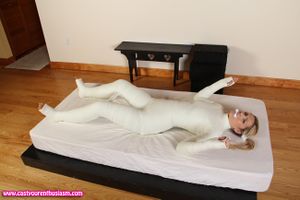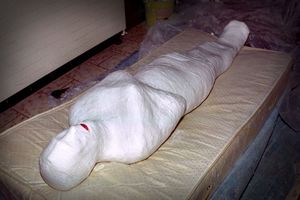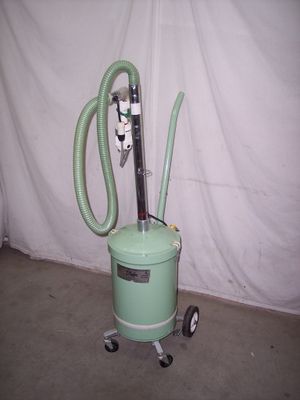Orthopedic cast
An orthopedic cast is a shell, frequently made from plaster, encasing a limb (or, in some cases, large portions of the body) to hold a broken bone (or bones) in place until it has healed.
Plaster bandages consist of a cotton bandage that has been impregnated with plaster of Paris, which hardens after it has been made wet. Plaster of Paris is calcined Gypsum, ground to a fine powder by milling. When water is added, the more soluble form of calcium sulfate returns to the relatively insoluble form, and heat is produced.
The setting of unmodified plaster starts about 10 minutes after mixing and is complete in about 45 minutes, the cast is not fully dry though for 72 hours.
Nowadays fiberglass bandages are often used. These consist of a knitted fiberglass bandage impregnated with polyurethane. These are lighter and dry much faster than plaster bandages. However, plaster can be more easily molded to make a snug and therefore more comfortable fit. In addition, plaster is much smoother and does not snag clothing or abrade the skin. Plaster casts are generally made available only to patients who insist on them, because they take more time to apply, or when the cost of the fiberglass material is a consideration.
Cast types
Upper Extremity Casts
Upper Extremity Casts are those which encase the arm, wrist, and/or hand. A long arm cast encases the arm from the hand to about 2 inches below the armpit, leaving the fingers and thumbs free. A short arm cast, in contrast, stops just below the elbow. Both varieties may, depending on the injury and the doctor's decision, include one or more fingers or the thumb, in which case it is called a finger spica or thumb spica cast.
Lower Extremity Casts
Newly applied short leg cast Lower Extremity Casts are classified similarly, with a cast encasing both the foot and the leg to the hip being called a long leg cast, while one covering only the foot and the lower leg is called a short leg cast. A walking heel may be applied, or a canvas or leather cast shoe provided to the patient who is expected to walk on the immobilized limb during convalescence (referred to as being weight-bearing). Where the patient is not to walk on the injured limb, crutches or a wheelchair may be provided. The sole of a leg cast may also be extended to the tip of the toes if providing a toe plate. This addition may be made to offer support to and stabilize the metatarsals and to protect the toes from additional trauma. This is a common treatment for a broken foot. Toe plates are infrequently used in the USA and are more common in continental Europe.
Cylinder cast
In some cases, a cast may include the upper and lower arm and the elbow but leaves the wrist and hand free, or the upper and lower leg and the knee, leaving the foot and ankle free. Such a cast may be called a cylinder cast, or may simply be called a long arm or long leg cast.
Body casts
Body casts, which cover the trunk of the body, and in some cases the neck up to or including the head (see Minerva Cast, below) or one or more limbs, are rarely used today and are most commonly used in the cases of small children, which cannot be trusted to comply with a brace, or in cases of radical surgery to repair an injury or other defect. A body cast that encases the trunk (with "straps" over the shoulders), is usually referred to as a body jacket.
Spica cast
A cast that includes the trunk of the body and one or more limbs is called a spica cast, just as a cast that includes the "trunk" of the arm and one or more fingers or the thumb is. For example, a shoulder spica includes the trunk of the body and one arm, usually to the wrist or hand. Shoulder spicas are almost never seen today, having been replaced with specialized splints and slings which allow early mobility of the injury so as to avoid joint stiffness after healing.
A hip spica includes the trunk of the body and one or more legs. A hip spica that covers only one leg to the ankle or foot may be referred to as a single hip spica, while one which covers both legs is called a double hip spica. A one-and-a-half hip spica encases one leg to the ankle or foot and the other to just above the knee. The extent to which the hip spica covers the trunk depends greatly on the injury and the surgeon; the spica may extend only to the navel, allowing mobility of the spine and the possibility of walking with the aid of crutches or may extend to the rib cage or even to the armpits in some rare cases. Hip spicas were formerly common in reducing femoral fractures, but today is rarely used except for congenital hip dislocations, and then mostly while the child is still an infant.
In some cases, a hip spica may only extend down one or more legs to above the knee. Such casts, called pantaloon casts, are occasionally seen to immobilize an injured lumbar spine or pelvis, in which case the trunk portion of the cast usually extends to the armpits.
Other casts
Other body casts which were used in decades past to protect an injured spine or as part of the treatment for a spinal deformity (see scoliosis) which are rarely seen today include the Minerva cast and Risser cast. The Minerva cast includes the trunk of the body (sometimes extending down only so far as the rib cage) as well as the patient's head, with openings provided for the patient's face, ears, and usually the top of the head and hair. The Risser cast was similar, extending from the patient's hips to the neck and sometimes including part of the head. Both of these casts could, with care and the doctor's permission, be walked in during convalescence. However, in some cases, the Risser cast would extend into one or more pantaloons, in which case mobility was far more restricted.
Aside from the above common forms, body casts could come in nearly any size and configuration. For example, from the 1910s to the 1970s, the use of a turnbuckle cast, which used metal turnbuckles to twist two halves of the cast so as to forcibly straighten the spine before surgery, was common. The turnbuckle cast had no single configuration, and could be as small as a body jacket split in half, or could include the head, one or both legs to the knees or feet, and/or one arm to the elbow or wrist depending on the choice of the doctor.
Despite the large size and extreme immobilization of some casts, particularly those used in or before the 1970s, the popular term full body cast is something of a misnomer. The popular and media-driven conception of a massive cast encasing all four limbs, the trunk, and the head - sometimes leaving only small slits for the eyes, nose, and mouth - is a true rarity in recorded medical history, and this type of large scale cast appears more commonly in throughout various Hollywood movies and on television shows. The term body cast (or full body cast) is sometimes casually used by laymen to describe any of a number of body and or spica casts, from a simple body jacket to a more extensive hip spica.
Care of casts
This section uses the general term `cast' and applies mostly to the care of limb casts. However, the principles and comments apply to both Plaster of Paris and fiberglass casts of all types.
A freshly applied cast should be treated gently until it is fully dried and has developed its full strength. Do not rest a fresh cast on a hard surface or it may become dented or distorted; rest it on a pillow or similar soft surface. Use a triangular sling to support a fresh upper limb cast, rather than a collar-and-cuff sling which will apply localized pressure to the cast.
Keep the casted part elevated as much as practical. This is particularly important in the first few days after injury or the application of a fresh cast. Exercise the fingers or toes through the full range of motion both actively and passively.
A cast should be snug, but not tight. A tight cast, or a cast that becomes tight because of swelling of the casted limb, can interfere with blood circulation in the limb. This can lead to a serious emergency condition similar to compartment syndrome. If the casted limb becomes increasingly painful, the fingers or toes change color to a dusky or white shade, become cold, lose motion or sensation, or there is increasing pain on passive extension of the digits, seek help immediately, day or night. The only treatment for this condition is to split the cast to relieve the pressure on the limb and enable normal circulation to return.
Do not let the cast get wet, or the skin underneath may become macerated. Do not use implements such as knitting needles or similar to scratch under the cast. This risks injury to the skin, which can then become infected. Seek immediate advice if any article falls into or becomes lodged inside the cast, or a discharge appears on the surface of the cast, or an unpleasant odor becomes apparent.
Comfort in a cast is a relative term, but, taking the underlying injury into account, casts themselves should not be painful. Seek advice if appropriate analgesia is not controlling pain, or if pain increases over time rather than decreases. Note that increasing analgesia in an attempt to manage increasing pain due to a tight cast will not work, and does not address the underlying condition.
See also [ Plaster cast fetish ]
Chat rooms • What links here • Copyright info • Contact information • Category:Root


